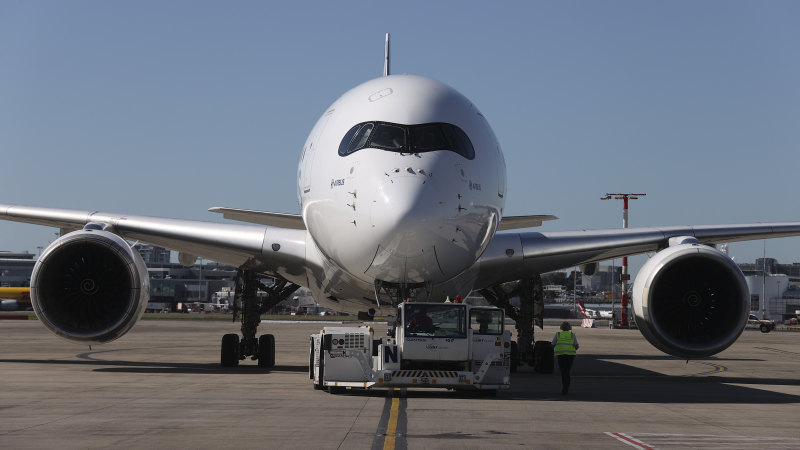Save articles for later
Add articles to your saved list and come back to them any time.
A pilotless aircraft? That’s the direction some see as the future of the commercial aviation industry, and it’s a scary prospect.
Pilotless aircraft have been around since the first drones were developed during World War II, and they’re being used increasingly by the military for surveillance and warfare. Under its project Skyborg, the US Air Force is developing AI-controlled unmanned combat aircraft designed to fly alongside manned fighter aircraft on high-risk missions. In December 2022, the USAF tested an AI-piloted F-16 fighter jet, operating 12 test flights and notching up more than 17 hours of autonomous flight time that included simulated dogfights.
Airbus’s Dragonfly system is being tested on an A350-1000 jet.
Military technology often creeps into civilian applications, and Airbus UpNext, owned by the aircraft manufacturer, is currently testing its Dragonfly technology in an Airbus A350-1000 aircraft. Using data from the aircraft’s sensors, the technology maps the landscape, enabling it to manoeuvre the aircraft independently of a human pilot.
The system has proven its worth, capable of assisting pilots in-flight when they’re called upon to manage an incapacitated crew member in a simulated event, generating a new flight plan and communicating with Air Traffic Control and the airline’s Operations Control Centre. Although Airbus is not saying as much, it’s another step in the quest for single pilot operation (SPO) of commercial aircraft.
SPO, the first step on the road to pilotless aircraft
Suppose the single pilot suffers a heart attack, a brain aneurysm or some other medical episode that renders them incapable of flying the aircraft? The automated flight system needs to take control, fly and land the aircraft.
Working out that the pilot is incapacitated is relatively simple if the system is constantly monitoring their vital functions. But if that control system can fly the aircraft independent of human intervention, does that make the pilot redundant? Could we see an autonomous system which could fly an aircraft using AI, without human intervention, and no pilot in the cockpit?
That’s a tantalising prospect for airlines. Autonomous systems don’t get sick, they don’t get tired, they don’t go on strike – and they don’t get paid.
The technological challenges of autonomous commercial flights are mind boggling. Pilots are regularly assessed on their ability to deal with extreme and unexpected situations on flight simulators. AI is a fast developing technology, but how would an autonomous system respond if a bird strike caused both engines to fail shortly after take-off? Could it then seek and detect a safe landing spot, as Captain Chesley Sullenberger famously did when he glided a stricken Airbus A320 to a safe landing on the Hudson River alongside New York City?
Driverless vehicles have been known to make flawed decisions in unforeseen circumstances. Last month a driverless Cruise robotaxi in San Francisco collided with a fire truck on an emergency call when the robotaxi failed to give way.
There’s a big difference between a drone or a pilotless combat aircraft and a commercial aircraft without a pilot. The former are controlled from the ground or from another aircraft, by an operator monitoring what the pilotless aircraft is doing and acting as a remote pilot. A commercial aircraft, in either SPO or pilotless mode, would need to be totally independent of remote control. If not, it could be hacked and hijacked, or flown into the nearest tall building.
“Having some remote access to controls like a remote pilot (think drones) would destroy the current security concept of having commercial jets separated from any outside connection,” according to former Qantas captain Bill Austen.
“At the moment absolutely no internet connection between the aircraft systems and the outside is allowed. Yes, the passengers get connected, but through a separate, isolated system. Even regular aircraft electronic system upgrades are done with floppy disc technology to keep these systems away from hackers.”
What are aviation regulators saying?
While pilots and their unions are universally opposed to the concept of single pilot operations, aviation regulatory bodies, responsible for the safe operation of the industry, are taking a closer look. The European Union Aviation Safety Agency is studying the subject of SPO operations in conjunction with the Netherlands Aerospace Centre. To be completed in August 2024, the study is looking at a number of critical areas including pilot workload, pilot error situations, pilot incapacitation, fatigue, sleep inertia, and breaks due to physiological needs.
An earlier study that compared SPO with two-crew and reduced crew operations conducted by the US Federal Aviation Administration and National Aeronautics and Space Administration found that “single pilot operations are not nominally acceptable due to the significant task demands and workload”.
However, the study also noted that technological developments that produced autonomous systems “with new functionalities, responsibilities, effective human-autonomy teaming” would facilitate SPO.
Should single pilot operations come to pass, it’s not likely to be aboard a commercial passenger aircraft.
“The more serious proposals about single pilots are actually only about freight aircraft,” according to Austen. “Apparently the occasional dead cargo pilot would be more acceptable than planeloads of passengers meeting their demise.”
The latest travel news, tips and inspiration delivered to your inbox. Sign up now.
Most viewed on Traveller
From our partners
Source: Read Full Article


